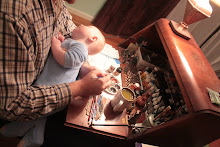Fighters are arguably THE core class of D&D. While clerics have their uses, and pages of pages of material are devoted to magic spells, it is difficult to imagine a game without a plain old guy with a sword or axe to protect the comparatively squishy magic users when they run out of spells. Indeed, in the OSR visions of D&D, low level magic users are nearly one shot weapons, where as the poor fighting man has to carry the main part of a battle.
Traditionally, there seems to be the view that fighters are some sort of movie-Conan type warriors, leaping to the forefront of battle with a broadsword, hacking and slashing their way to victory. Alternately, they are depicted as some sort of tank, heavily armed and armored, holding the line while the magic users do the real work. Both of these visions are possible with role play, but the rules tend to fall somewhere in the middle.
In the Deepest Sea, fighters are soldiers, mercenaries, bandits, knights, guards, and bravos, all those who earn a living by the strength of arms. That is not to say that they are unintelligent, but rather, that their skill set is mostly martial in nature. Some of them are nobles, particularly if they are knights, but most are common soldiers, or their analog, bandits. All races have fighters, because war and conflict are ever present. Indeed the feudal system of government which pervades most of the land breeds conflict, by creating in effect local warlords with loyalty only to the next most powerful warlord.
Unlike historical reality, women fight somewhat more frequently in the Deepest Sea setting. Due to the pervasive nature of magic, and the nearly total equality of Elves, even human women take up arms on occasion, although would still be viewed as being unusual in most areas. Dwarven women rarely take arms outside of defense of their community, and havling women are more likely to go adventuring than the men are.
Sub-classes of fighter include Rangers and Paladins. Rangers are fighters who spend their time as scouts, border guards, and woodsmen, and consequently have a deep connection and experience with the wilderness. This connection gives them the bonuses mentioned in the Labyrinth Lord Advanced Edition Companion. [Paladins will be addressed separately when we get to letter P]
NPC Fighters have a 3/4 chance of being male, and a 1/20 chance of being nobles. 5/6 of the time they will be human (modified by location). 9/10 of the time they will be from the country in which they are currently located. 1/4 of them are 15-20 years old, 2/4 of them are 21-30, and 1/4 are 31-50. In any random adventuring party, 3/5 of the members are fighters.
When handling fighters in a game, it is important to remember where they came from. Are they sell-swords, or are they knights, with a sworn feudal duty to an overlord? Do they owe certain duties to their lord? Must they be present at a muster of arms every year? No one is completely free of obligations, and properly understood, these give hooks and levers to tie the player to the story, and move them when necessary.
Many of the more wealthy might look like this guy:
(Picture from Bing image search)
So anyway, a quick review of fighters in the Deepest Sea.
Tomorrow, more Deepest Sea A-Z, with a discussion of Grit.


No comments:
Post a Comment